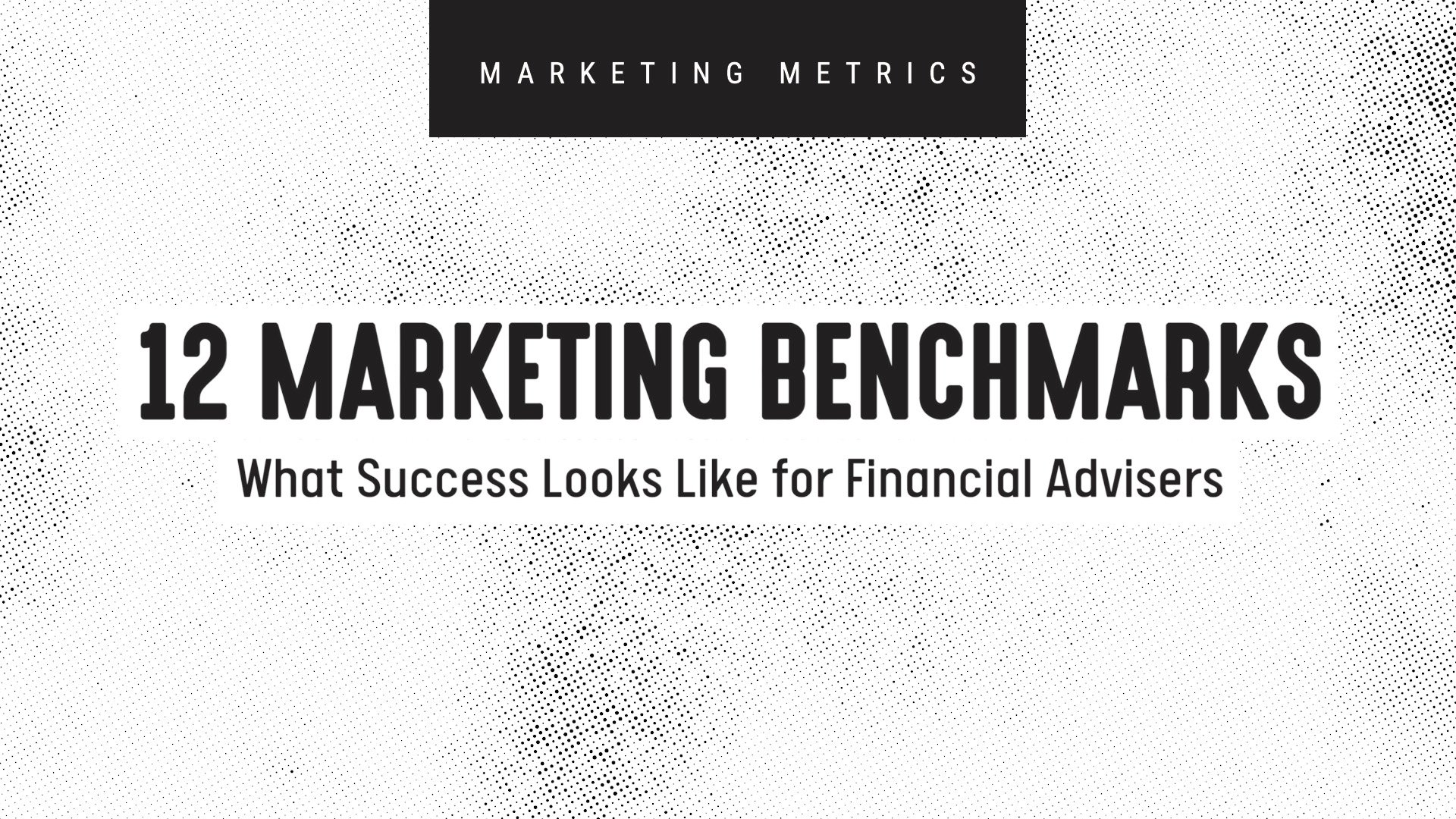What Success Looks Like for Financial Advisers
8-minute Read | 9-Minute Listen
Marketing benchmarks and success look different in every industry and for every business. For example, the average email open rate in the business and finance industry is 21.56%, while the average open rate for government emails is 28.77%. Apart from industry, other factors affect performance like company size and maturity.
Industry averages tell you how other businesses are doing and let you know how you’re doing in comparison. At the end of the day, you need to define what success looks like for your business by analyzing past performance to create your own benchmarks.
Here are the most important metrics on social media, for emails, and for referrals and how to find them:
(Note: All industry averages in this article are specific to the financial industry unless otherwise indicated.)
![]()

4 Key Social Media Marketing Metrics
Tracking social media metrics is easy because each site has its own analytics dashboard that you can access through your account. If you’re using a growth program like Snappy Kraken, you can also access analytics through your data dashboard.
Here are four important metrics that you can track through a data dashboard or manually through a spreadsheet.
1. Engagement Rate
Your engagement rate is the number of people who liked, commented, shared, favorited, or clicked on your post compared to the number of people who saw it. Tracking engagement rate is important because it tells you if your content is grabbing attention and “stopping the scroll.”
Here are the average engagement rates on social media:
Manually calculate your engagement rate by dividing the number of interactions per post by the total number of impressions per post (i.e., how many people have seen your post). If you’re using a social media scheduler or tracker, you can usually find engagement rates in your analytics dashboard.
2. Click-Through Rate
Click-through rate (CTR) is the number of people who clicked your post compared to the number of people who saw your post. The number of clicks your ads or post gets is a strong indicator of how interested your audience is in what you have to offer.
Here are the industry averages for social media CTR:
- Facebook: 0.56% (Note: Snappy Kraken members see an average CTR of 0.67%)
- LinkedIn (across all industries): 0.27%
- Twitter (across all industries) 1.55%
Manually calculate CTR by dividing the number of people who saw your ad by the number of people who clicked it. If you’re using marketing software or a social media scheduler, you can get CTR data through your analytics dashboard.
3. Cost Per Click
Cost Per Click (CPC) is the cost of each click you get on your ads. Social media sites generally charge you for impressions, so if you got 10 clicks on an ad that reached 100 people and cost $100, then your CPC is $10.00. Tracking how much money you put into ads will tell you whether your ad channel is helping you grow or just wasting money.
Here are the industry averages for social media CPC:
There’s a large discrepancy across social media platforms because each platform has different types of users. Facebook has a large audience of 2.8 billion monthly users, so you’re probably going to get more clicks on Facebook compared to other platforms. However, your audience on LinkedIn is more likely to become clients because the platform is directed toward more finance-oriented folks.
You can find CPC on each social media platform’s analytics dashboard (e.g., Facebook Business Suite, Twitter Analytics, and LinkedIn Page Analytics).
4. Social Media Conversion Rate
Your social media conversion rate is the number of people who did the desired action compared to the number of people who saw your page after they clicked on your social media ad. The desired action can be filling out a lead generation form, watching a video, booking a call, and so on.
Here are the industry averages for social media conversion rate:
- Facebook ads: 9.09% (Note: Snappy Kraken members see an average conversion rate of 13%)
- LinkedIn (across all industries): 5% to 15%
Since conversion refers to so many different actions, it’s hard to peg a specific average, which is why the range for LinkedIn is so wide, and Twitter isn’t even on the list.
You can find your social media conversion rate by looking at your website analytics or the data dashboards found on each platform (if you have tracking set up).
![]()

5 Key Email Marketing Metrics
Most financial advisers think that their email marketing performance should be way higher than what is reasonable—after all, it’s one of the main acquisition channels. But we’re here to tell you that you’re probably doing better than you think.
Most of these metrics you can find in your email marketing tool’s data dashboard or Snappy Kraken’s data dashboard.
1. Bounce Rate – 11.55%
An email bounces when it doesn’t reach the intended recipient. Emails usually bounce because of typos in the email address, fake email addresses from a bought list, a full inbox, or your email address is blocked. Tracking bounce rate is important because it tells you when it’s time to clean your email list.
The average bounce rate in the financial industry is 11.55%.
2. Open Rate – 21.56%
Your open rate is the number of people who open your emails compared to the number of people who received them. A high open rate means your subject line was compelling enough to make the receiver want to read the rest of your email.
The average email open rate in the financial industry is 21.56%. (Note: Snappy Kraken members see an open rate of at least 27%.)
3. Click-Through Rate – 2.72%
Similar to your social media CTR, your email CTR indicates the number of people who clicked the links in your emails. Tracking email CTR tells you how many people are interested in your links or offer if you linked to a free resource.
The average CTR in the financial industry is 2.72%. (Note: Snappy Kraken members see an average CTR of 35.8% because we encourage them to use video landing pages in their emails.)
4. Unsubscribe Rate – 0.20%
People who don’t want to receive communications from you can unsubscribe to your list—by the way, don’t panic if people unsubscribe; it happens to everyone, every day. By giving your audience the option to opt out of communications, you are remaining compliant and keeping your list clean. Tracking your unsubscribe rate is important so that you can gauge if your prospects are still interested in the content you’re sending out.
The average number of unsubscribes per email in the financial industry is 0.20%.
Quick Tip: Figure out why your prospects are unsubscribing by creating an exit survey for people who unsubscribe.
5. Email Conversion Rate
Your email conversion rate is similar to your social media conversion rate—it’s the number of people who complete your desired action compared to the total number of people who opened your email. Your desired action can be clicking on a blog post link, booking a call, becoming a client, or other things that you’d like your prospects or clients to do when they see your email. Track your conversion rate to know if your offers and message are compelling enough to get receivers to take action.
There is no average email conversion rate because there are so many different types of emails. For example, in the eCommerce industry, the welcome email gets a 51.94% conversion rate, while the birthday email gets a 10.57% conversion rate.
Just a simple change in messaging can drastically improve or hurt your conversion rate.
![]()

3 Referral Marketing Metrics
Referrals are highly important in the financial adviser industry. In fact, asking clients for referrals is one of the top marketing tactics used by Registered Investment Advisers (RIAs). Here are metrics to gauge referral marketing success:
1. Net Promoter Score – 56/100
Your Net Promoter Score (NPS) indicates how happy your clients are with your services and how willing they are to recommend you to their friends and family. The NPS is rated on a scale from 1 to 100. Tracking NPS tells how satisfied your clients are with your services and where you can improve.
The average NPS in the finance industry is 56 out of 100.
You can get your score by sending your clients an NPS survey through sites like Qualtrics or Typeform.
2. Referrals Per Client – 2.68
The more referrals you get per client, the better your referral flywheel is performing.
There isn’t really a benchmark for how many clients you should get per referral because it varies greatly per firm—as long as you keep your clients happy, you’ll get referrals. But in 2017, SaaSquatch found that the average referring client shares products or services with 2.68 other people.
You can track how many referrals you’re getting per client through referral program software or by manually tracking client referrals (take note, the manual route can get messy).
3. Referred Prospect Conversion Rate – 3.74%
Not all referred prospects will convert—here, a conversion happens when your referred prospect becomes a client. Knowing how many do will tell you how effective your referral flywheel and sales processes are.
The average conversion rate for referred clients across different industries is 3.74%.
You can calculate referred client conversion rate by dividing the number of referrals that became clients by the total number of referrals.
The Most Important Benchmarks Are Against Your Past Self
When you’re just starting out, comparing yourself to an established company doesn’t make much sense. In the same way, when your company consistently performs above industry average, these numbers won’t motivate you to grow.
Use the numbers in this article to compare yourself to other people, but determine growth and success by creating your own benchmarks and comparing your current performance to those benchmarks.
Keep getting better and winning against your past self so that your firm keeps growing. Check out Snappy Kraken’s growth program if you want all your data in one place and tried-and-tested campaigns that will keep getting you better results.
Book A Demo Today
Discover how Snappy Kraken helps advisors grow with a powerful marketing system
Request a demo


